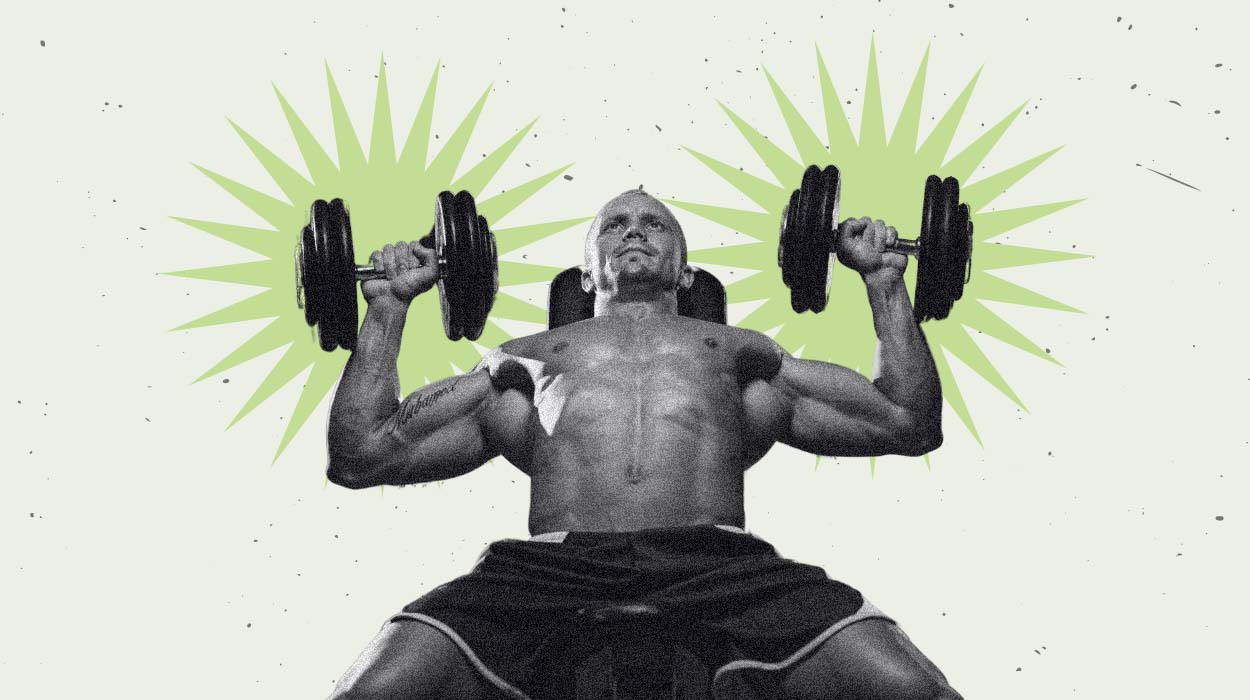
If you’re short on time or don’t have gym access, you can still achieve your chest-building goals with just a few dumbbell chest exercises. Many pressing movements strengthen your pec and shoulder muscles. We’ve gathered the best exercises that can be incorporated into any type of workout routine such as a 3-day workout split or a 5-day workout split. Grab your gear and let’s get to work on the best chest workouts with dumbbells at home, no bench.
Chest Workouts At Home With Dumbbells
- Standing dumbbell upward fly
- Dumbbell floor chest press
- Dumbbell alternating chest press
- Dumbbell pullover on an exercise ball
- Dumbbell push up
- Dumbbell floor hammer press
- Dumbbell chest fly
By incorporating these exercises into your regular at-home routine, you will save time and build strong muscles. Plus, exercise is a mood booster! Make sure to start with the proper amount of weight, focus on the muscles you’re using, and track your workouts to see progress over time!
Dumbbell Chest Exercises At Home
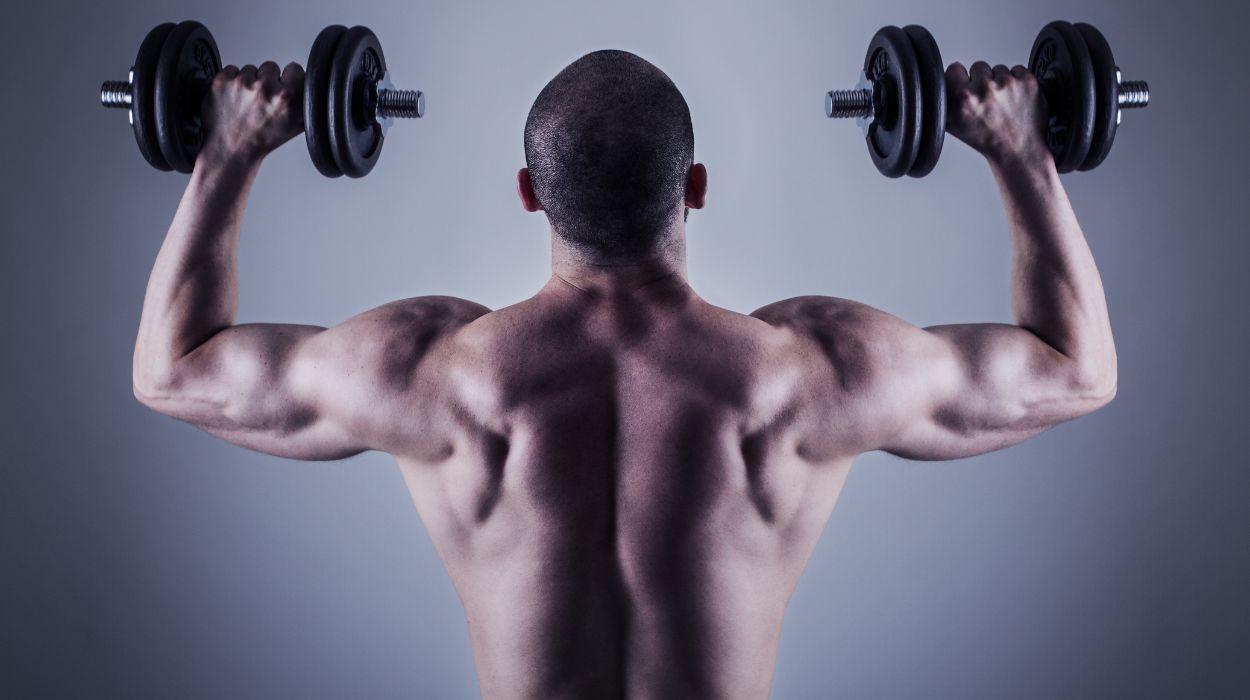
Standing Dumbbell Upward Fly
The Standing Dumbbell Upward Fly targets the shoulder muscles, specifically the deltoids. This exercise improves shoulder strength and mobility, essential for upper-body conditioning. It’s performed with controlled, outward lifts of dumbbells, enhancing both muscle tone and stability.
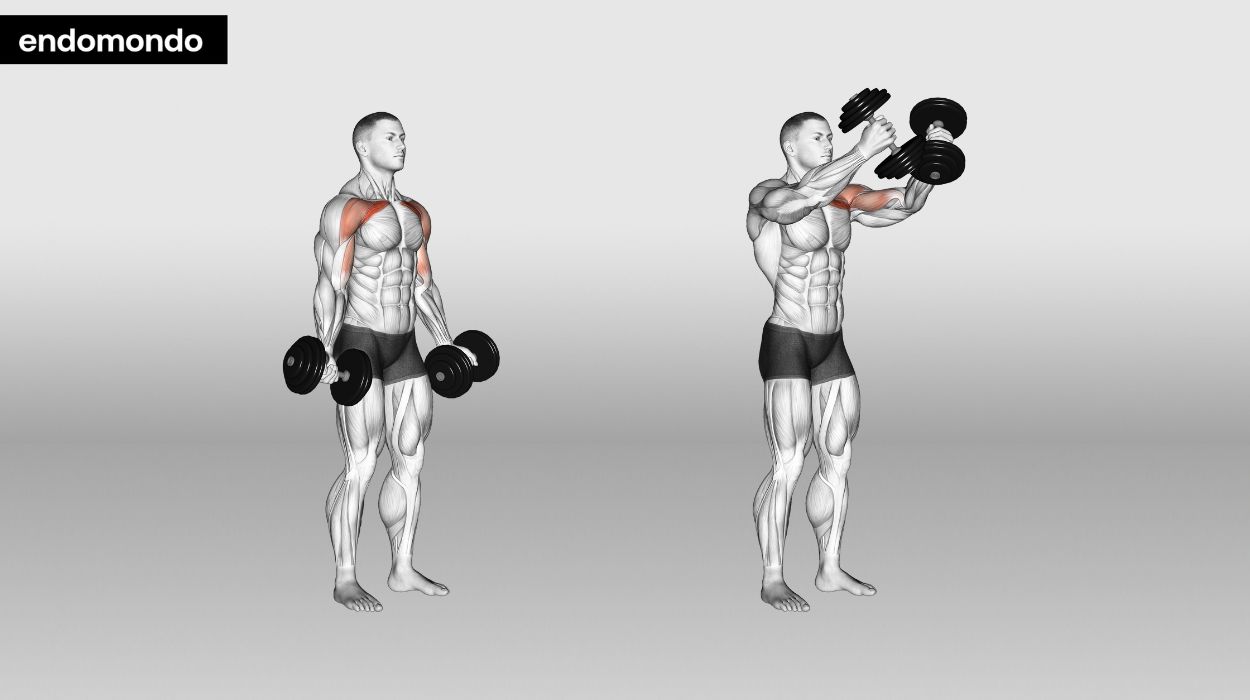
How to do:
- Stand straight, feet shoulder-width apart, holding dumbbells at sides.
- Lift arms outward to shoulder height, elbows slightly bent.
- Rotate wrists so palms face upwards at the top.
- Pause briefly, then lower the dumbbells slowly to the starting position.
- Keep movements controlled and fluid throughout.
Tips:
- Maintain Posture: Keep your back straight and avoid leaning forward or backward during the exercise.
- Elbow Alignment: Keep your elbows slightly bent throughout the lift to prevent joint strain.
- Controlled Movement: Raise and lower the dumbbells smoothly to engage the shoulder muscles effectively.
Optimal Sets and Reps: Aim for 3 to 4 sets of 10 to 15 reps each.
Dumbbell Floor Chest Press
This floor-based exercise is a variation of the classic dumbbell bench press, performed without a bench. Lying flat on the back with knees bent, involves pressing dumbbells directly overhead and then lowering them slowly, effectively targeting the chest, shoulders, and triceps, enhancing upper body strength.
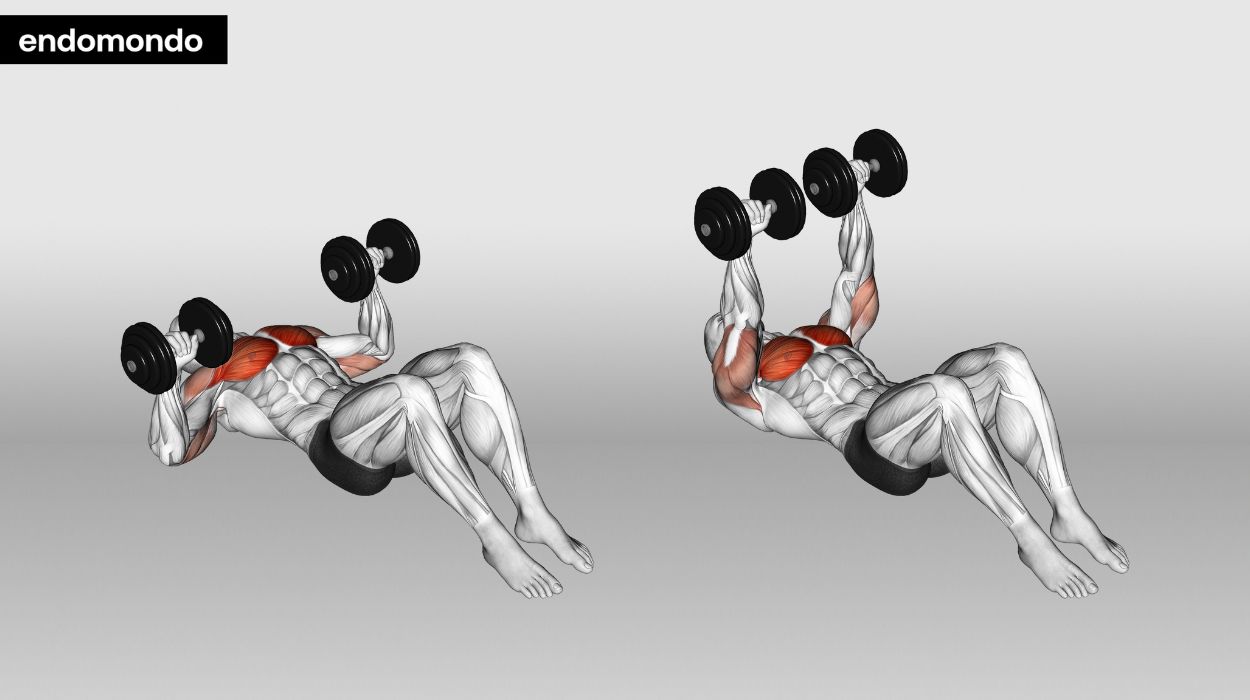
How to do:
- Place a dumbbell vertically on each side of you.
- Lay on your back with knees bent, and feet flat.
- Grab a dumbbell in each hand, over your shoulders.
- Keep elbows at a 45-degree angle from your body.
- Press dumbbells up above your chest.
- Slowly lower until your upper arms touch the ground.
- Mimic a “dumbbell bench press” without the bench.
Tips:
- Elbow Position: Keep your elbows at a 45-degree angle to your body to maximize chest engagement and reduce shoulder strain.
- Controlled Motion: Lower the dumbbells slowly and press up powerfully, maintaining control throughout the movement.
- Stable Base: Plant your feet firmly on the ground and engage your core for stability during the exercise.
Optimal Sets and Reps: Aim for 3 to 4 sets of 10-12 reps each.
Dumbbell Alternating Chest Press
This exercise is a dumbbell floor chest press variation. Instead of moving both arms at the same time, you will alternate. Only one arm is moving while the other is stationary either resting on the ground or holding the weight stable in the air.

How to do:
- Lie flat on the bench, dumbbells in your hands above your shoulders.
- Feet flat on the floor, back slightly arched.
- Lower one dumbbell to the chest, keeping the elbow at 90 degrees.
- Press it back up, then alternate with the other arm.
- Continue alternating arms in a controlled manner.
Tips:
- Maintain Balance: Keep your core engaged to stabilize your body as you alternate arms.
- Controlled Movements: Lower each dumbbell slowly and press up with control, focusing on the chest muscles.
- Even Pacing: Maintain a consistent pace for each arm to ensure balanced muscle development.
Optimal Sets and Reps: Perform 3 to 4 sets of 8 to 10 reps per arm.
Dumbbell Pullover On Exercise Ball
The Dumbbell Pullover on an Exercise Ball is a full-body workout targeting the chest, back, and core. Performed by lying with the upper back on the ball, it involves extending a dumbbell overhead and then pulling it over the chest, engaging multiple muscle groups and enhancing stability.
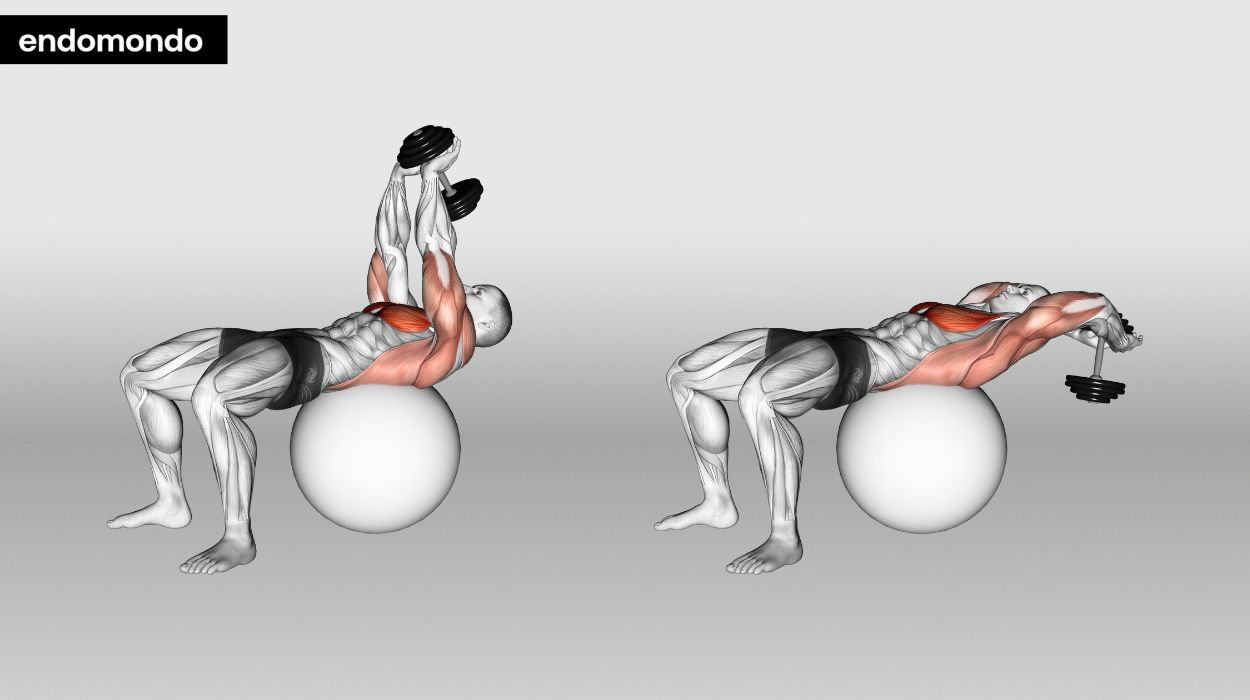
How to do:
- Sit on an exercise ball with a dumbbell in your lap.
- Walk your feet forward, rolling until your upper back rests on the ball.
- Feet firmly planted on the ground.
- Press the weight up above your chest.
- With elbows slightly bent, extend your arms back towards your head.
- Extend until the biceps are beside the ears, as range allows.
- Pull the dumbbell back to the starting position.
Tips:
- Stable Base: Keep your feet flat and hips raised for a stable, balanced base throughout the exercise.
- Controlled Movement: Move the dumbbell in a slow, controlled arc, keeping your arms slightly bent at the elbows.
- Engage Core: Actively engage your core and glutes to maintain a straight line from shoulders to knees.
Optimal Sets and Reps: Aim for 3 sets of 10-12 reps each.
Dumbbell Push-Up
The dumbbell push-up is an enhanced version of the classic push-up, using dumbbells for increased depth and range of motion. This exercise strengthens the chest, arms, and core, promoting stability and upper body conditioning. It’s an effective way to intensify a traditional push-up with added challenge and muscle engagement.
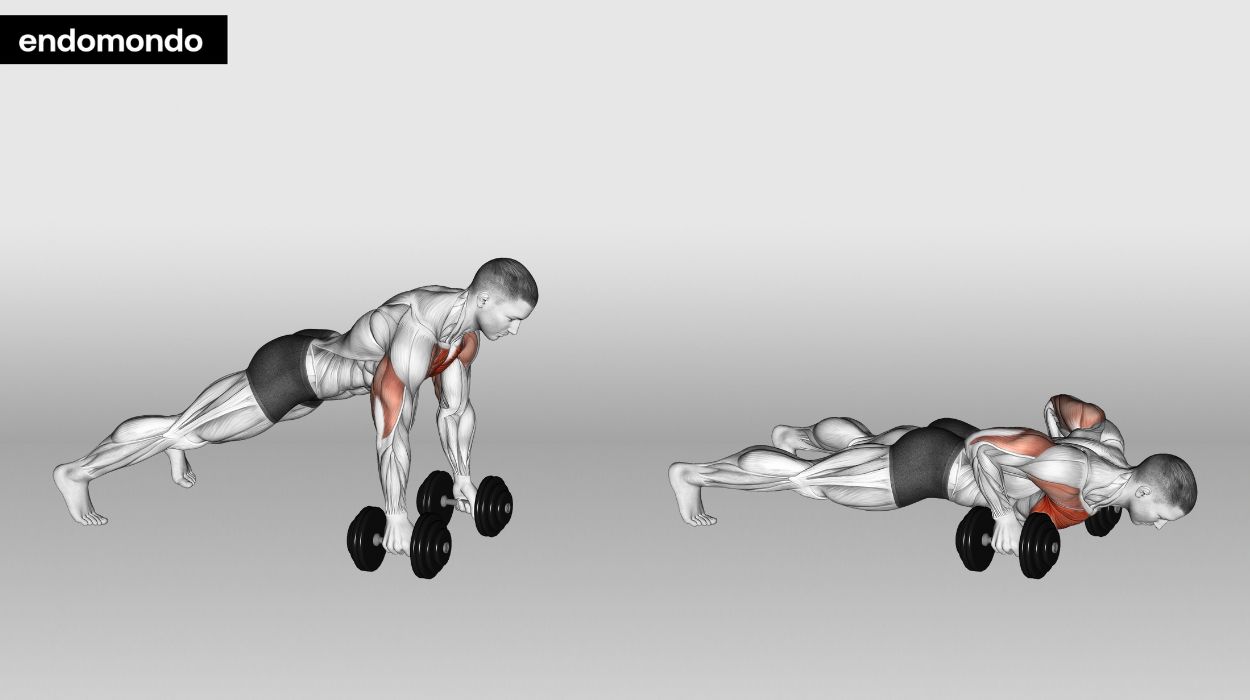
How to do:
- Get one dumbbell for each hand.
- Place dumbbells perpendicular, shoulder-width apart on the floor.
- Hands-on dumbbell handles, start in a plank position.
- Lower your upper body towards the ground.
- Aim for a rib cage below the hands for full-range motion.
- Push back up to the starting position.
Tips:
- Wrist Position: Keep your wrists straight and aligned with your forearms to prevent strain.
- Steady Plank: Maintain a strong plank position with a straight back and engaged core throughout the exercise.
- Depth and Control: Lower your body until your chest is just above the dumbbells, then push back up with controlled strength.
Optimal Sets and Reps: Perform 3 to 4 sets of 8 to 12 reps each.
Dumbbell Floor Hammer Press
The Dumbbell Floor Hammer Press is an effective chest exercise performed lying flat on the floor. It involves pressing dumbbells upwards from a position with elbows bent at 90 degrees, focusing on chest muscles while reducing shoulder involvement. This variation emphasizes controlled movements and muscle engagement in the chest.

How to do:
- Have two dumbbells, one in each hand.
- Lay on the floor, knees bent, feet flat.
- Start with upper arms on the floor, elbows bent at 90 degrees.
- Press the dumbbells up directly above your chest.
- Lower back to the starting position in a controlled manner.
- This exercise also strengthens your front delts.
Tips:
- Elbow Alignment: Keep your elbows close to your body to target the chest and minimize shoulder strain.
- Controlled Motion: Press the dumbbells up with control and lower them slowly to maximize muscle engagement.
- Wrist Position: Maintain a neutral wrist position, like holding a hammer, throughout the exercise.
Optimal Sets and Reps: Aim for 3 to 4 sets of 10-12 reps each.
Dumbbell Chest Fly
This dumbbell chest workout is a targeted exercise for chest muscles, emphasizing stretching and contracting the pectorals. Performed lying on the back with knees bent, it involves moving weights in an arc from a wide position to meeting above the chest. This exercise enhances chest strength and definition.
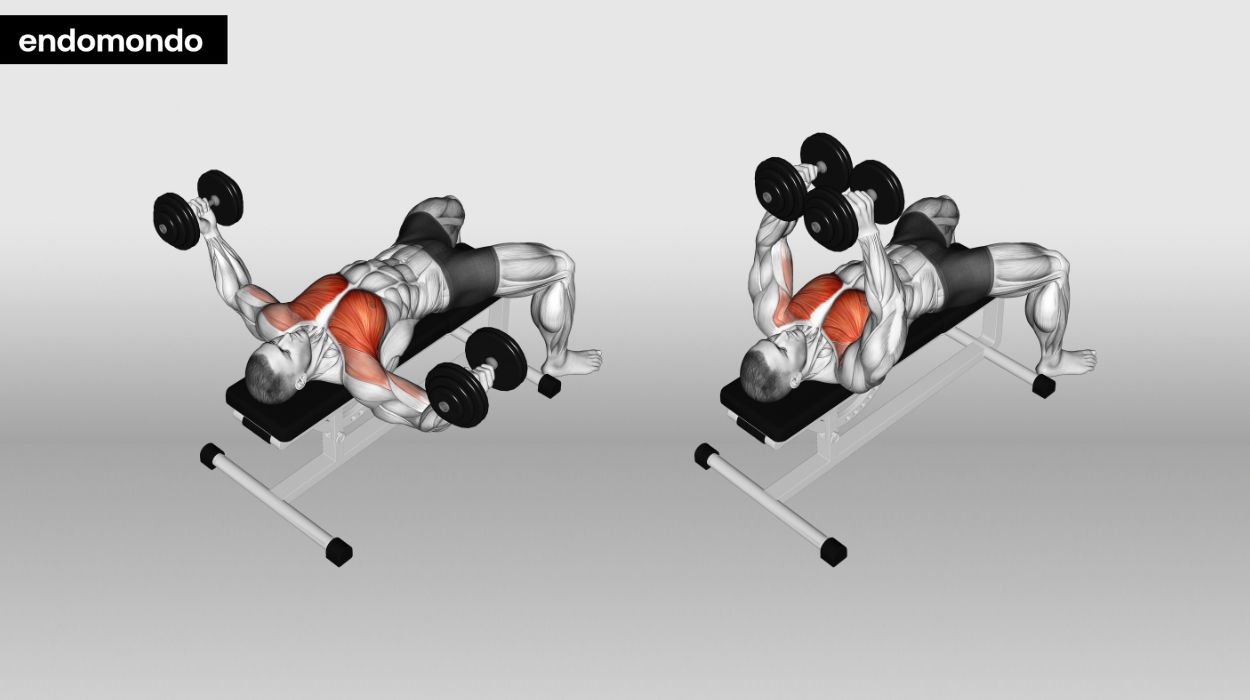
How to do:
- Lay on your back, knees bent, feet on the ground.
- Hold a weight in each hand, arms extended to the sides, forming a T shape.
- Keep elbows slightly bent while bringing weights together above your chest.
- Slowly lower the weights back to the starting position.
Tips:
- Maintain A Slight Bend: Keep a slight bend in your elbows throughout the movement to protect your joints.
- Controlled Arc: Move the dumbbells in a smooth, controlled arc, feeling the stretch and contraction in your chest.
- Stable Core: Engage your core and keep your back flat against the bench for stability and support.
Optimal Sets and Reps: Perform 3 to 4 sets of 10-12 reps each.
Benefits Of Doing Chest Workouts At Home With Dumbbells
Builds Muscle
A strong physique is admirable; it shows dedication and persistence and resistance training is the best type of workout to build bigger and stronger muscles. By doing these dumbbell chest workouts once or twice per week you will see upper chest and lower chest development in about six to 10 weeks.[1]
Time Efficient
Since you’re not spending time driving to or from the gym, you are saving a lot of time that can be spent with friends, and family or doing other tasks in your day. By having dumbbells at home you won’t have to wait for someone else to finish with the ones you want.
Boosts Your Mood
Lifting weights has been shown to improve overall mood and mental health.[2] It may improve feelings of self-worth, improve feelings of tranquility, decrease the occurrence of depression, and decrease fatigue. Many people become drained by all of the responsibilities they have between work, friends and families, and household tasks. Completing a good workout is one way to dedicate time to yourself and help improve your mental and physical health.
Tips For At-Home Chest Workouts With Dumbbells

Start With The Correct Weight
Finding the correct weight to begin can be tricky. You want to have heavy enough weights to challenge yourself but not too much that you may injure yourself. You should be able to complete at least six repetitions and up to 12[3] repetitions. If you can’t do six reps, the weight is too heavy. If you feel like you can do more than 12, go heavier.
Squeeze
Think about squeezing your chest muscles at the end of the range of motion. Concentrate on that muscle contraction throughout the movement so your body doesn’t compensate with other muscles. Focusing on the muscle[4] that you’re targeting can help increase muscle size.
Track Your Workout
Progressive overload is the regular increase in the intensity of the workout to develop bigger and stronger muscles. Make sure to keep track of the weights, sets, and repetitions in a notebook or on your phone. Studies show that it takes anywhere from six to 20 sets per muscle group[5] per week to grow muscle.
Conclusion
You don’t need to work at a gym to see improvements in muscle size. We just went through the best dumbbell chest exercises that you can start doing today. The most important thing is to stay consistent toward your goals!
Frequently Asked Questions
The pectoralis major and pectoralis minor are the main chest muscles.
Aim to get four to six movements that involve the pectoral muscles per workout session.
Many of these exercises also target your serratus anterior. This muscle pulls your shoulder blades forward and is important for shoulder health.
You can, but it is not necessary. If you want to incorporate any sort of incline dumbbell bench press into your routine, a bench would be helpful.
Resources
- Michał Krzysztofik, Wilk, M., Grzegorz Wojdała and Artur Gołaś (2019). Maximizing Muscle Hypertrophy: A Systematic Review of Advanced Resistance Training Techniques and Methods. International Journal of Environmental Research and Public Health, [online] 16(24), pp.4897–4897. doi:https://doi.org/10.3390/ijerph16244897.
- Westcott, W.L. (2012). Resistance Training is Medicine. Current Sports Medicine Reports, [online] 11(4), pp.209–216. doi:https://doi.org/10.1249/jsr.0b013e31825dabb8.
- Schöenfeld, B.J. (2010). The Mechanisms of Muscle Hypertrophy and Their Application to Resistance Training. Journal of Strength and Conditioning Research, [online] 24(10), pp.2857–2872. doi:https://doi.org/10.1519/jsc.0b013e3181e840f3.
- Schöenfeld, B.J., Vigotsky, A.D., Contreras, B., Golden, S., Alto, A., Larson, R., Winkelman, N. and Paoli, A. (2018). Differential effects of attentional focus strategies during long-term resistance training. European Journal of Sport Science, [online] 18(5), pp.705–712. doi:https://doi.org/10.1080/17461391.2018.1447020.
- Eneko Baz-Valle, Maelán Fontes-Villalba and Santos-Concejero, J. (2021). Total Number of Sets as a Training Volume Quantification Method for Muscle Hypertrophy: A Systematic Review. Journal of Strength and Conditioning Research, [online] 35(3), pp.870–878. doi:https://doi.org/10.1519/jsc.0000000000002776.




